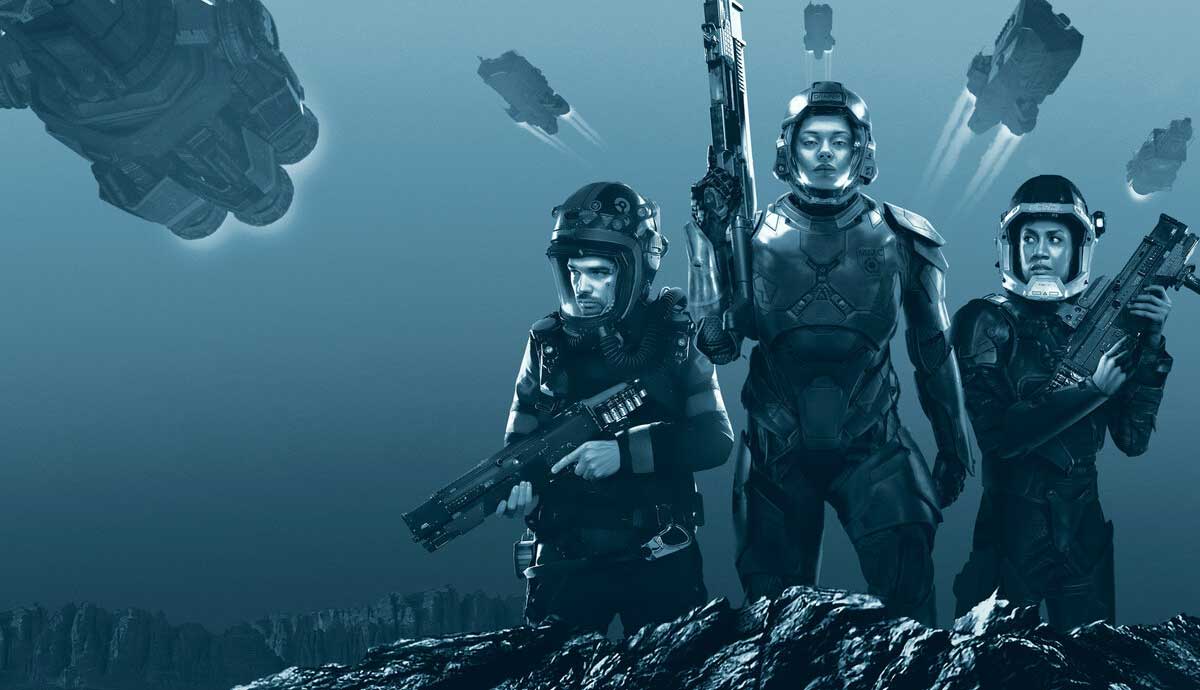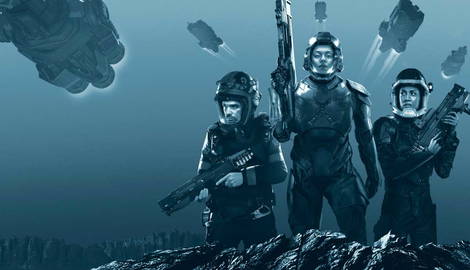
Science fiction has been with us for over a hundred years, and during that time, it has developed many different genres and sub-genres to cover every niche that has been created. The human audience is a fickle one. What is chic becomes passé quickly, and the desire for new aesthetics and ideas leads to the creation of sub-genres as writers, filmmakers, and artists explore their imaginations, creating the unreal, drawing from the possible as well as the impossible.
Like in art, defining genres is the easy part. Deciding where everything fits, however, is the real challenge, as so many examples have themes that overlap with certain genres. As such, new genres have to be invented regularly to accommodate the examples that are difficult to categorize. From space operas to comedy, here are 7 examples of genres defined by science fiction themes, including the differences between what is considered “hard” and “soft” science fiction.
1. & 2. The Difference Between Hard & Soft Science Fiction

It is important to distinguish what constitutes “hard” and “soft” science fiction. Hard science fiction is when technology is the main focus. It shapes the world and the aesthetic and becomes the defining feature of the story. Certain aesthetics get their own genres and don’t even need stories to exist. For example, genres like steampunk and cyberpunk generate a massive and hugely successful cosplay movement that exists outside of the stories meant to define them.
Soft science fiction, on the other hand, focuses on how technology has affected characters and the world around them. It is less focused on how the technology works and feels no need to explain it. The focus is on the characters, their interactions, and their psychology.

While this dichotomy is a neat way for us to split science fiction down the middle, it is a bit too simplistic to envelop the entire complexity of individual science-fiction stories. An alternative classification system proposed by Isaac Asimov in 1953 suggests that each science fiction plot exists in one of three categories: gadget, adventure, or social.
A “gadget” story revolves around the invention itself. The invention is the end result of the plot. An “adventure” story uses the invention as a prop. The story’s main focus is on the adventure itself and how the invention helps or hinders the characters. “Social” stories focus on how inventions affect people’s lives. The chief difference is that in social stories, the invention influences the plot rather than being the cause or goal of the plot.
Predictably, many stories and franchises cross these designations quite easily and exist across attempts to categorize them in such simple manners.
3. Space Opera

The “space opera” is a genre that includes a vast number of science fiction stories and one into which many stories overlap. Space operas are the science fiction equivalents of historical epics. The stories feature vast distances involving many worlds and planets. There are huge casts of characters and sweeping, emotional stories. A perfect example of this categorization is Frank Herbert’s Dune. Apart from the seminal book Dune being an example of an epic story in and of itself, the space opera that is the Dune anthology would include another five sequels in the original series written by Frank Herbert. There have been a plethora of subsequent additions to the Dune universe, with Kevin J. Anderson and Brian Herbert adding around two dozen books to the franchise, each adding to the space operatic themes of the originals.
In many regards, Star Trek and Star Wars could also be considered space operas. They both feature a vast array of characters playing stories over vast distances in space and over long periods. Both franchises are science fiction, but where Star Trek focuses on realistic depictions of technological progress, which is centered on real-life physics, Star Wars does not. The latter features elements (such as the Force) that, in a fantasy setting, would be considered magic.
4. Cyberpunk

Cyberpunk is a dystopian theme or setting which is characterized by advanced technology and a breakdown in standards of living. It is one where corporations often control society, and many people struggle to survive. Many writers use cyberpunk as a harsh criticism of how they see the future of society under free-market, predatory capitalism. The United States and Japan are generally the targets for such critiques, as these two countries have generated the most cyberpunk media. What’s interesting is that cyberpunk visions of the future often incorporate a fusion of American and Japanese cultures.

Common themes in cyberpunk are corporate control, ecological collapse, huge megacities, cybernetic enhancement, the gap between rich and poor, artificial intelligence, and transhumanism. The genre was created in the late 1970s with the comic Judge Dredd and continued through novels such as Philip K. Dick’s Do Androids Dream of Electric Sheep? which was turned into the movie Blade Runner (1982), and William Gibson’s novel Neuromancer, which drew inspiration from the punk culture of the 1980s and the early hacker culture. Cyberpunk also found much popularity in Japan within the anime industry.
The genre has garnered much traction in recent years as many of the themes have inched closer to being an actual reality. Notable movies include Akira (1988), Johnny Mnemonic (1995), The Matrix film series, and more recently, Blade Runner 2049 (2017) and Alita: Battle Angel (2019). Recent series such as Netflix’s Altered Carbon and video games such as CDProjekt Red’s Cyberpunk 2077 have successfully maintained cyberpunk as a prominent science fiction genre.
5. Steampunk

With its roots in the late 19th century, steampunk is a re-envisioned science fiction genre that draws inspiration from the aesthetic of early science fiction before the invention of the combustion engine, and during the Victorian Era. As such, technology within the steampunk genre generally revolves around the application of steam power. Other technological hallmarks are airships, analog computers, and automata. Settings often center around the Industrial Revolution. The works of Jules Verne formed a foundation of the steampunk style.
Steampunk envisions an alternate future presented by the Victorian aesthetic and, as such, involves a high degree of design and fashion. Because of this, the steampunk genre has a strong cosplay following. In films, the genre has been represented by films such as The League of Extraordinary Gentlemen (2003), Abraham Lincoln: Vampire Hunter (2012), Howl’s Moving Castle (2004), and Wild Wild West (1999).
6. Post-Apocalyptic Science Fiction

Ever since Mad Max hit our screens in 1979, post-apocalyptic science fiction has been an ever-growing form of science fiction. Of course, this sub-genre of science fiction existed long before Mad Max. In fact, post-apocalyptic fiction goes as far back as forming a thematic portion of the Epic of Gilgamesh, the first story ever recorded (2100 BCE). Mad Max, however, popularized post-apocalyptic science fiction in modern memory.
Post-apocalyptic science fiction is a setting whereby the world has been destroyed by an apocalypse. The type of apocalypse often affects the setting and how the characters interact with it. A nuclear apocalypse, for example, leaves radioactivity as a significant factor in trying to survive, and a zombie apocalypse leaves survivors constantly evading hordes of the undead or infected people trying to bite them. Apocalyptic and post-apocalyptic science fiction can be further broken down into sub-genres based on the type of apocalypse.

Themes in post-apocalyptic science fiction often revolve around humankind’s struggle for survival and the barbarity that people are forced to commit and endure. As such, cannibalism becomes a common theme in post-apocalyptic science fiction.
In addition to the Mad Max franchise, popular works of post-apocalyptic fiction include A Boy and His Dog, written in 1969 and turned into a film in 1975; Escape from New York (1981), Escape From L.A. (1996), and possibly the most depressing story ever written: Cormack McCarthy’s The Road, written in 2006 and turned into a major motion picture in 2009.
Post-apocalyptic science fiction has also been massively popular in video games. Prominent examples include the Fallout series (since 1997), The Last of Us (2013), Horizon Zero Dawn (2017), and the Metro series (since 2010), among many, many others.
7. Cosmic Horror

As its name suggests, cosmic horror is also a horror genre. Popularized in the early 20th century with the writings of H.P. Lovecraft, cosmic horror tells horrifying stories of malevolent and enigmatic things from the vastness of space and how they interact with human characters.
During the era of pulp magazines, cosmic horror was a common theme, and in more recent times, the genre has been translated to film. Notable examples include Alien (1979), the cult favorite Event Horizon (1997), Annihilation (2018), and Color Out of Space (2019), which is the film version of H.P. Lovecraft’s The Colour Out of Space, written in 1927.

There are, of course, many more subgenres of science fiction. Comedy science fiction, such as HBO’s Avenue 5, tells the story of the mishaps of a cruise liner in space. Lower Decks is an animated Star Trek series that focuses on less important crewmembers of a spaceship. Rick and Morty is about the adventures of a hapless boy and his drunk grandfather, who also happens to be a space, time, and dimension traveler.
Like cyberpunk and steampunk, genres such as dieselpunk and raypunk have emerged, the former being a retro-futuristic focus on aesthetics from the 1930s and 1940s, while the latter focuses on aesthetics and themes from the 1950s.
Science fiction is limited only by the imaginations of its creators. Through this, we are sure to be further introduced to a vast number of genres and sub-genres within the realms of science fiction, many of which will astound us with their unique visions.











